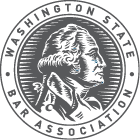Supreme Court Work Group to Review WSBA Structure
In September 2018, the Washington Supreme Court announced it would undertake a “comprehensive review of the structure of the bar” in light of recent case law with First Amendment and antitrust implications for bar associations. The Court directed the WSBA Board of Governors to defer all action on potential bylaw amendments until further notice. In November 2018, the Court provided a charter for a 10-member work group to review WSBA’s structure and make a recommendation back to the Court in six to eight months.
Update:On Sept. 25, 2019, the Washington Supreme Court issued a response to the Work Group’s final report. On Sept. 4, 2019, the Work Group completed its final report, including a minority report. |
Public Comments
Frequently Asked Questions
Work Group Roster
Work Group Structure and Timeline
- Composition: Chief Justice Mary Fairhurst, chair; three members from the WSBA Board of Governors; three members from the WSBA Sections; three members from Supreme Court-appointed boards that WSBA administers; one public member.
- Charter: To review and assess WSBA structure in light of (1) recent case law with First Amendment and antitrust implications; (2) recent reorganizations by other state Bar associations and/or groups and their reasoning; and (3) the additional responsibilities of the WSBA due to its administration of Supreme Court appointed boards.
- Expected duration: Six to eight months with meetings every three to four weeks. (Note: Current and pending lawsuits have the potential to influence the Court’s options and timeline.)
- Outcome: A recommendation to the Supreme Court as to future structure (for example, whether to maintain the status quo; divide into two organizations—one mandatory and one voluntary; or do some sort of hybrid)
Meetings
All meetings will be open to the public and held at WSBA Conference Center, 1325 Fourth Ave., Suite 600, Seattle. All meetings will be webcast and recorded, and will remain available for viewing.
Call into meetings at 866-577-9294; passcode: 613585#
Please mute your phone when not speaking.
Meeting Schedule
|
Thursday, March 28, 9 a.m.–noon |
Agenda | Materials | Notes | Watch Video |
|
Monday, April 8, 1–4 p.m. |
Agenda | Materials | Notes | Watch Video |
|
Monday, May 6, 9 a.m.–noon |
Agenda | Materials | Notes | Watch Video |
|
Wednesday, May 29, 2–5 p.m. |
Agenda | Materials | Notes | Watch Video |
|
Monday, June 10, 9 a.m.–noon |
Agenda | Materials | Notes | Watch Video |
|
Wednesday, June 26, 1–4 p.m. |
Agenda | Materials | Notes | Watch Video |
|
Monday, July 8, 9 a.m.– noon |
Agenda | Materials | Notes | Watch Video |
|
Wednesday, July 17, 1–4 p.m. |
Agenda | Materials | Notes | Watch Video |
Meetin g Resources and Documents
All meeting materials are accessible here.
Resources
- Washington Supreme Court Order approving bylaw amendments regarding members of the Board of Governors. (January 2018)
- Washington Supreme Court letter announcing a comprehensive review of the structure of the bar and directing the Board of Governors to defer all action on proposed bylaw amendments until further notice. (September 2018)
- Letter from Chief Justice Mary Fairhurst outlining the composition and timeline for the work group. (November 2018) link to Supreme Court Work Group on WSBA
- Column in NWLawyer magazine about restructuring from the WSBA Executive Director and President. (November 2018)
- Question-and-answer session with Chief Justice Mary Fairhurst at the Sept. 27 Board of Governors meeting (video starting at 12 minutes, 40 seconds). (September 2018)
- WSBA presentation on bar structures and case law at the national level. (September 2018) Link to Supreme Court Cases Overview
- WSBA Entities Chart
- Media release soliciting public-member for Supreme Court work group link to press release
- Relevant case law:
- Janus v. American Federation of State, County, and Municipal Employees, Council 31, No. 16-1466, 585 U.S. ___ (2018)
- Keller v. State Bar of California, 496 U.S. 1 (1990)
- Lathrop v. Donohue, 367 U.S. 820 (1961)
- North Carolina State Board of Dental Examiners v. FTC
- Arnold Fleck, Petitioner v. Joe Wetch, et al (8th Circuit)
- Arnold Fleck, Petitioner v. Joe Wetch, et al (SCOTUS)
- § Note: The U.S. Supreme Court in December 2018 granted petition, vacated the judgment, and remanded Fleck to 8th Circuit for further consideration in light of Janus
Frequently Asked Questions
FAQ 1: What’s the impetus?
A: For several years, bar leaders nationwide have observed several cases significant to mandatory bar associations work their way to the U.S. Supreme Court. First was a 2015 ruling (North Carolina State Board of Dental Examiners v. FTC) that deprived regulatory boards of anti-trust immunity when the boards are composed of active market participants that are not actively supervised by the state. Then this past June, the Court reversed long-standing precedent in public-sector labor union cases in Janus v. AFSCME. According to Janus, under the First Amendment, a state may no longer compel employees who are not union members to pay a percentage of full union dues to fund the union’s collective bargaining activities. While Janus does not directly relate to bar associations, it overturns case law relied on in Keller v. State Bar of California, a 1990 U.S. Supreme Court decision authorizing state bars to assess mandatory membership fees as long as those fees are not used in ways that violate objecting members’ First Amendment rights. After Janus, which did not explicitly overrule Keller, we do not know whether Keller is still good law. However, that could soon change. In December 2018, the U.S. Supreme Court acted on an 8th Circuit case (Fleck v. Wetch) that directly challenges Keller as well as earlier case law (Lathrop v. Donohue); the Court granted the petition, vacated the judgment, and remanded Fleck back to the U.S. Court of Appeals for the 8th Circuit for further consideration in light of Janus. Meanwhile, lawyers in some mandatory bar states have been quick to argue that the Janus ruling applies to bar associations. In light of this shifting legal landscape, the Washington Supreme Court in September unanimously decided to review WSBA’s structure.
FAQ 2: What’s the question at hand?
A: Are there concerns about WSBA's integrated structure and its related functions in light of recent antitrust and First Amendment decisions, and, if so, how do we address those concerns? Bars across the nation are set up in various ways. Some are voluntary, with members choosing to join for professional services and the state supreme court overseeing all regulatory functions. Others are mandatory, with members required to join, and the bar may or may not administer regulatory functions (e.g., Wisconsin is mandatory but does not administer regulatory functions; Virginia and North Carolina are mandatory but only administer regulatory functions and there is a second voluntary state bar associations as well in each of these states). WSBA is an integrated bar, which means members are required to join, and the bar administers both regulatory functions as well as professional-association services. Unlike some other states with integrated bars, in Washington the Supreme Court has delegated all regulatory functions to WSBA to administer on its behalf. The aforementioned federal precedent has implications for both regulatory agencies and professional associations.
FAQ 3: What is WSBA’s role in the process?
A: As bar leaders, we have for years been closely tracking national trends in bar restructuring and reporting back to the Board of Governors and the Washington Supreme Court. After the Janus decision, a loose assemblage formed that includes WSBA’s executive management staff, legal practitioners and scholars, Board of Governors members, section leaders, and other stakeholders. This group has grown as we have presented information to groups like section leaders and invited them to participate. Our focus has been twofold: 1) To develop appropriate legal lenses based on recent U.S. Supreme Court decisions to evaluate our bar functions; and 2) To apply those lenses to the full spectrum of WSBA functions, from regulatory duties like discipline to permissive functions like providing a practice-management discount program. Our preliminary lenses quickly came together:
- Antitrust Immunity (North Carolina): To preserve state-action immunity, the Bar Association activity must be based on a clearly articulated state policy, and, if performed by active market participants (lawyers or other legal professionals), must be actively supervised by the Washington Supreme Court.
- First Amendment (Janus): To the extent that WSBA’s activities burden a member’s First Amendment right to freedom of speech and association, mandatory bar membership must 1) serve a compelling governmental interest (i.e., regulating the practice of law and improving the quality of legal services available to the people of the state), and 2) that interest must be achieved through the least-restrictive means.
We also asked another critical question about each function: Is this something members should be paying for as part of a mandatory license fee? We know that’s top on members’ minds as well. As you can imagine, our conversations have been robust. The anti-trust analysis has been more straightforward, such as ensuring all regulatory boards are appointed and subject to active oversight by the Court. As for the First Amendment filter, that’s a harder nut to crack.
Here’s an example: When you consider the impact of addiction on our profession, the counseling services provided through WSBA’s Member Wellness Program may serve a compelling state interest in ensuring competent and qualified legal professionals. But WSBA’s Member Wellness Program is a robust resource offering our members a full range of counseling, personal finance, family care giving and convenience services. The tool can help you locate a pet sitter or provide travel advice. Does that service seem like the least-restrictive means of achieving the compelling interest it serves? Does the answer change when you consider that many lawyers starting their practice spend long hours in the office and need resources to maintain healthy home-life balance? These are complicated questions. As we move forward with the Court’s work group, we will use what we have learned in our own exploratory process to serve as a resource.
FAQ 4: Have any other bars recently bifurcated or changed from mandatory to voluntary?
A: Several bars have changed or are investigating change, either through judicial or legislative means. Looking at the legal landscape, the California Supreme Court in 2017 issued an antitrust policy related to the state bar and formed sections into a separate organization. In 2013, the Nebraska Supreme Court bifurcated the regulatory and professional association functions and transitioned the bar to a voluntary association. Unrelated to recent case law, the Arizona, Wisconsin, and Michigan supreme courts each recently investigated whether and how to de-unify or restructure bar functions.






